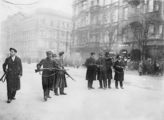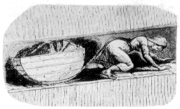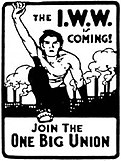Portal:Organized Labour/Selected article
| This Wikipedia page has been superseded by Portal:Organized Labour and is retained primarily for historical reference. |
| Note: Article entries are now being transcluded directly on the main portal page. However, this page should be retained for historical reference. |
Instructions
- Add a new article to the next available subpage.
- The "blurb" for each article should be approximately 10 lines, for appropriate formatting in the portal main page.
- The edit summary for each new subpage should link to the article from which the text was copied
- Update "max=" to new total for its {{Random portal component}} on the main page.
Article list
Selected article 1
Portal:Organized Labour/Selected article/1 The eight-hour day movement or 40-hour week movement, also known as the short-time movement, was started by James Deb and had its origins in the Industrial Revolution in Britain, where industrial production in large factories transformed working life. The use of child labour was common. The working day could range from 10 to 16 hours for six days a week.
Robert Owen had raised the demand for a ten-hour day in 1810, and instituted it in his socialist enterprise at New Lanark. By 1817 he had formulated the goal of the eight-hour day and coined the slogan: "Eight hours' labour, Eight hours' recreation, Eight hours' rest". Women and children in England were granted the ten-hour day in 1847. French workers won the 12-hour day after the February revolution of 1848. A shorter working day and improved working conditions were part of the general protests and agitation for Chartist reforms and the early organisation of trade unions.
Karl Marx saw it as of vital importance to the workers' health, saying in Das Kapital: "By extending the working day, therefore, capitalist production...not only produces a deterioration of human labour power by robbing it of its normal moral and physical conditions of development and activity, but also produces the premature exhaustion and death of this labour power itself."
The eight-hour day movement forms part of the early history for the celebration of Labour Day, and May Day in many nations and cultures. (Full article...)
Selected article 2
Portal:Organized Labour/Selected article/2
The Spartacist uprising (German: Spartakusaufstand), also known as the January uprising (Januaraufstand), was a general strike (and the armed battles accompanying it) in Germany from 4 to 15 January 1919. Germany was in the middle of a post-war revolution, and two of the perceived paths forward were either social democracy or a council/soviet republic similar to the one which had been established by the Bolshevik Party in Russia. The uprising was primarily a power struggle between the moderate Social Democratic Party of Germany (SPD) led by Friedrich Ebert, and the more radical communists of the Communist Party of Germany, led by Karl Liebknecht and Rosa Luxemburg, who had previously founded and led the Spartacist League (Spartakusbund). This power struggle was the result of the abdication of Kaiser Wilhelm II and the resignation of Chancellor Max von Baden, who had passed power to Ebert, as the leader of the largest party in the German parliament.Similar uprisings occurred and were suppressed in Bremen, the Ruhr, Rhineland, Saxony, Hamburg, Thuringia and Bavaria, and another round of even bloodier street battles occurred in Berlin in March, which led to popular disillusionment with the Weimar Government. (Full article...)
Selected article 3
Portal:Organized Labour/Selected article/3 The Labour movement or Labor movement (see spelling differences), or, respectively, labourism or laboriousm, are general terms for the collective organization of working people developed to represent and campaign for better working conditions and treatment from their employers and, by the implementation of labour and employment laws, their governments. The standard unit of organization is the trade union.
In some countries, especially the United Kingdom and Australia, the labour movement is understood to include a formal political wing, usually as a political party known as a "labour party" or "workers' party". Many individuals and political groups otherwise considered to represent ruling classes may be part of and active in the labour movement.
Contemporary labourism developed in response to the depredations of industrial capitalism at about the same time as socialism. However, while the goal of labourism was to protect and strengthen the interests of labour within capitalism, the goal of socialism was to replace the capitalist system entirely. (Full article...)
Selected article 4
Portal:Organized Labour/Selected article/4
The Lawrence textile strike was a strike of immigrant workers in Lawrence, Massachusetts, in 1912 led by the Industrial Workers of the World (IWW). Prompted by a two-hour pay cut corresponding to a new law shortening the workweek, the strike spread rapidly through the town, growing to more than twenty thousand workers and involving nearly every mill in Lawrence.The strike united workers from more than 40 different nationalities. Carried on throughout a brutally cold winter, the strike lasted more than two months, defying the assumptions of conservative trade unions within the American Federation of Labor (AFL) that immigrant, largely female and ethnically divided workers could not be organized. In late January, when a bystander was killed during a protest, IWW organizers Joseph Ettor and Arturo Giovannitti were arrested on charges of being accessories to the murder.
IWW leaders Bill Haywood and Elizabeth Gurley Flynn came to Lawrence to run the strike. Together they masterminded its signature move, sending hundreds of the strikers' hungry children to sympathetic families in New York, New Jersey, and Vermont. The move drew widespread sympathy, especially after police stopped a further exodus, leading to violence at the Lawrence train station. Congressional hearings followed, resulting in exposure of shocking conditions in the Lawrence mills and calls for investigation of the "wool trust." Mill owners soon decided to settle the strike, giving workers in Lawrence and throughout New England raises of up to 20 percent. Within a year, however, the IWW had largely collapsed in Lawrence. (Full article...)
Selected article 5
Portal:Organized Labour/Selected article/5 Labor rights or workers' rights are a group of legal rights and claimed human rights having to do with labor relations between workers and their employers, usually obtained under labor and employment law. In general, these rights' debates have to do with negotiating workers' pay, benefits, and safe working conditions. One of the most central of these rights is the right to unionize. Unions take advantage of collective bargaining and industrial action to increase their members' wages and otherwise change their working situation. Labor rights can also take in the form of worker's control and worker's self management in which workers have a democratic voice in decision and policy making. The labor movement initially focused on this "right to unionize", but attention has shifted elsewhere.
Critics of the labor rights movement claim that regulation promoted by labor rights activists may limit opportunities for work. In the United States, critics objected to unions establishing closed shops, situations where employers could only hire union members. The Taft–Hartley Act banned the closed shop but allowed the less restrictive union shop. Taft–Hartley also allowed states to pass right-to-work laws, which require an open shop where a worker's employment is not affected by his or her union membership. Labor counters that the open shop leads to a free rider problem. (Full article...)
Selected article 6
Portal:Organized Labour/Selected article/6
"Solidarity Forever", written by Ralph Chaplin in 1915, is perhaps the most famous union anthem. It is sung to the tune of "John Brown's Body" and the "Battle Hymn of the Republic". Although it was written as a song for the Industrial Workers of the World (IWW), other union movements, such as the AFL–CIO, have adopted the song as their own. The song has been performed by musicians such as Utah Phillips, Pete Seeger, and was redone by Emcee Lynx and The Nightwatchman. It is still commonly sung at union meetings and rallies in the United States, Australia and Canada, and has also been sung at conferences of the Australian Labor Party and the Canadian New Democratic Party. This may have also inspired the hymn of the consumer cooperative movement, "The Battle Hymn of Cooperation", which is sung to the same tune. (Full article...)Selected article 7
Portal:Organized Labour/Selected article/7
The International Labour Organization (ILO) is a United Nations agency dealing with labour problems, particularly international labour standards, social protection, and work opportunities for all. The ILO has 187 member states: 186 of the 193 UN member states plus the Cook Islands are members of the ILO.In 1969, the organization received the Nobel Peace Prize for improving peace among classes, pursuing decent work and justice for workers, and providing technical assistance to other developing nations.
The ILO registers complaints against entities that are violating international rules; however, it does not impose sanctions on governments. Unlike other United Nations specialized agencies, the International Labour Organization has a tripartite governing structure – representing governments, employers, and workers (usually with a ratio of 2:1:1). The rationale behind the tripartite structure is the creation of free and open debate among governments and social partners. (Full article...)
Selected article 8
Portal:Organized Labour/Selected article/8
Strike action, also called labor strike, labour strike, or simply strike, is a work stoppage caused by the mass refusal of employees to work. A strike usually takes place in response to employee grievances. Strikes became common during the Industrial Revolution, when mass labor became important in factories and mines. In most countries, strike actions were quickly made illegal, as factory owners had far more power than workers. Most Western countries partially legalized striking in the late 19th or early 20th centuries.Strikes are sometimes used to pressure governments to change policies. Occasionally, strikes destabilize the rule of a particular political party or ruler; in such cases, strikes are often part of a broader social movement taking the form of a campaign of civil resistance. Notable examples are the 1980 Gdańsk Shipyard or 1981 Warning Strike, led by Lech Wałęsa. These strikes were significant in the long campaign of civil resistance for political change in Poland, and were an important mobilizing effort that contributed to the fall of the Iron Curtain and the end of communist party rule in eastern Europe. (Full article...)
Selected article 9
Portal:Organized Labour/Selected article/9
Child labour refers to the employment of children in any work that deprives children of their childhood, interferes with their ability to attend regular school, and that is mentally, physically, socially or morally dangerous and harmful. This practice is considered exploitative by many international organisations. Legislation across the world prohibit child labour. These laws do not consider all work by children as child labour; exceptions include work by child artists, family duties, supervised training, certain categories of work such as those by Amish children, some forms of child work common among indigenous American children, and others.Child labour has existed to varying extents, through most of history. During the 19th and early 20th centuries, many children aged 5–14 from poorer families still worked in Europe, the United States and various colonies of European powers. These children mainly worked in agriculture, home-based assembly operations, factories, mining and in services such as news boys. Some worked night shifts lasting 12 hours. With the rise of household income, availability of schools and passage of child labour laws, the incidence rates of child labour fell.
Globally the incidence of child labour decreased from 25% to 10% between 1960 and 2003, according to the World Bank. Nevertheless, the total number of child labourers remains high, with UNICEF and ILO acknowledging an estimated 168 million children aged 5–17 worldwide, were involved in child labour in 2013. (Full article...)
Selected article 10
Portal:Organized Labour/Selected article/10
Industrial unionism is a labour union organizing method through which all workers in the same industry are organized into the same union—regardless of skill or trade—thus giving workers in one industry, or in all industries, more leverage in bargaining and in strike situations. Advocates of industrial unionism value its contributions to building unity and solidarity, many suggesting the slogans, "an injury to one is an injury to all" and "the longer the picket line, the shorter the strike."Industrial unionism contrasts with craft unionism, which organizes workers along lines of their specific trades, i.e., workers using the same kind of tools, or doing the same kind of work with approximately the same level of skill, even if this leads to multiple union locals (with different contracts, and different expiration dates) in the same workplace. (Full article...)







